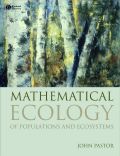
This is a major new introductory textbook on mathematical ecology bridging the subdisciplines of population ecology and ecosystem ecology. The book is ideal for beginning graduate and advanced undergraduate students, with some background in basic calculus, linear algebra, and basic ecology. INDICE: PrefaceAims, scope, and outline of the book; mathematical and ecological preparation required.Part I. Introduction and Mathematical Preliminaries.Chapter 1. IntroductionWhy do mathematical ecology?Understanding and predictingTheoretical problems vs. empirical problemsCommon errors of perception of mathematical modelsMathematical models are analogues of biological systemsApproaches to mathematical ecology.Chapter 2. Mathematical PrologueNumbers, operations, and closureMatrix Algebra and Linear SystemsLimits, derivatives, differential equationsEigenvalues and eigenvectorsTaylor SeriesNumerical methods (Runga-Kutta).Part II. Linear Models of Single Populations.Chapter 3. Non-structured Models: Homogeneous populationsExponential growth, exponential decay. Equilibrium, eigenvalue, stability, and bifurcation of exponential modelGeometric model. Equilibrium, eigenvalue, stability, and bifurcation of geometric modelRelationship between exponential and geometric models.Chapter 4. Structured Linear Models: Relaxing assumption of population homogeneityAge structure. Eulers equation. Leslie matrix. Historical background: Peter Leslie and Eltons ecologists. The Leslie matrix. Eigenvalues and eigenvectors of the Leslie matrix. Stable age distribution and population growth ratesStage structure. Life-stage models. Dominant eigenvalue and eigenvectorMarkov models of landscapes. Historical background: Markov. The Markov matrix. Dominant eigenvalue and eigenvectorSemimarkov models: relaxing assumption of constancy of transition probabilities. Sojourn functions. An age-stage model of a landscape.Part III. Non-Linear Models of Single Populations.Chapter 5. The logistic model: Continuous timeHistorical background: Verhulst, PearlDeriving the logistic model: relaxing assumption of constant birth and death in the exponential model.What K and r are.Why K and r are correlatedEquilibrium, eigenvalues, and stability of the logistic modelTranscritical bifurcation in the logistic modelOther ways of representingdensity-dependence and generalized logistic models.Chapter 6. Harvesting in the continuous time logistic modelHarvesting functions: a precursor of functional responses.Quota (Type 0) harvesting, proportional (Type 1) harvesting, hyperbolic (Type II) harvesting, and sigmoidal (Type III) harvestingHow harvestingaffects equilibria and stability. Saddle node bifurcation with quota, proportional, and hyperbolic harvesting. Cusp-catastrophe (co-dimension 2 bifurcation) with sigmoidal harvesting.Chapter 7. Logistic maps in discrete timeDifferentways of deriving logistic maps. The quadratic map. The Ricker model.The Beverton-Holt modelStability and period doubling bifurcations in the quadratic map.Part IV. Non-linear models of Two Species.Chapter 8. Two species, no interaction: the null modelThe phase plane, nullclines, vector fields, and equilibriaNullclines are orthogonalRelaxing assumption of independence of species causes loss of orthogonality of nullclines.Chapter 9. Two species competitionHistorical Note: Lotka and VolterraThe Lotka-Volterra competition model: intensity of competition is proportional to the probability that two individuals of different species meet.Equilibria, The Jacobian, eigenvalues, and stability near equilibriaSaddle nodes and stable nodes and their dependence on intensity of competition.Chapter 10. Two species mutualismLotka-Volterra type mutualism modelThe problem of stability with positive feedbacksDeans modelAn alternative to Deansmodel.Chapter 11. Predator-prey modelsPer capita functional responses of a predator: linear, hyperbolic, sigmoidal, and ratio dependentBasic Lotka-Volterrapredator-prey model: linear per capita functional response of predator: Equilibria, imaginary eigenvalues, and oscillations with neutral stabilityVolterrasmodification with logistic growth of prey: Equilibria, eigenvalues, and stable fixed pointsRosenzweig-MacArthur model using logistic growth and hyperbolic functional response: Equilibria, eigenvalues, and the birth of limit cycles; the Hopf bifurcationRosenzweig-MacArthur model with sigmoidal functional responseHarvesting in predator-prey models: does hunting wolves help?Kolmogorovs Theorem and stability of two species modelsNo cycles possible in Lotka-Volterra competition and mutualism models, but cycles are possible in predator-prey models.Chapter 12. More than two speciesGeneralized Lotka-Volterra modelsGraphs and the Qualitative analysis of food webs.Quirk-Ruppert criteria.Routh-Hurwitz criteria.Part IV. Resources, the Constraints of Mass Balance, and Ecosystems.Chapter 13. Mass Balance and Conservation of Matter in EcosystemsMass balance and conservation of matter dispenses with the need for carrying capacity termsInputs, outputs, turnover, residence times, resilience and their relation to eigenvalues.Chapter 14. UptakeThe Michaelis-Menten function and its derivationNutrient-use efficiencyMultiple nutrient limitations and variations on Michealis-Menten models.Chapter 15. Uptake and Competition for a Single ResourceTilmans R* model and its stability: no coexistence of species and the competitive exclusion principleHow two species can coexist on a single resource: the Armstrong-McGehee model. Non-linear uptake functions that cross allow coexistence and alimit cycle.Chapter 16. Decomposition and the behavior of nitrogenBehavior ofcarbon and mass during decomposition. Continuous vs. periodic inputs of litter. Relaxing assumption of chemical homogeneityBehavior of nitrogen during decomposition: microbial uptake and release of nitrogen.Chapter 17. Litter return,decay and nutrient cyclesAdding litter return to the R* model: Neutral stability without coexistenceInput-output balance, Lotka-Volterra competition between two plant species, and bifurcations in a nutrient cycling model of peatlandsRelaxing homogeneity of resource pool: Mass balance limits to species richness.Chapter 18. Herbivores and nutrient cyclingRosenzweigs paradox of enrichment in resource-producer-herbivore models without litter feedbackOne-herbivore-oneplant species with litter feedback: eigenvalues, stability, and effects on nutrient cycling ratesOne herbivore and two plants with different decay rates and Lotka-Volterra consumption rates: coexistence with decreased nutrient cycling rateHerbivores and input-output budgets.Chapter 19. Nutrient ratios and stoichiometry: simultaneous mass balance of two or more nutrientsWhy stoichiometryis important and how it constraions allowable solutionsThe Loladze et al. model and bifurcations between energy-enrichment and nutrient-enrichment.Part V. Spatially structured models.Chapter 20. Implicit spatial structure: metapopulation models.Chapter 21. Explicit spatial structureLinked models and the lateral transport of nutrients along gradientsFickian diffusion model and its derivationReaction-diffusion models, Turing instability, and the origins of spatial patterns. Turing instability in predator-prey models with diffusion. Turing instability in a hydrologic model of peatlands
- ISBN: 978-1-4051-8811-1
- Editorial: Blackwell
- Encuadernacion: Cartoné
- Páginas: 320
- Fecha Publicación: 01/07/2008
- Nº Volúmenes: 1
- Idioma: Inglés
